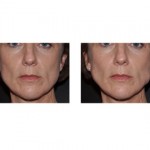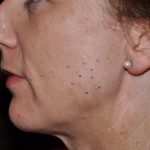Teeth clenching, otherwise known as bruxism, is a common phenomenon amongst many people. To some degree, almost everybody clenches his or her teeth. The issue lies in the intensity of the teeth clenching is. A person with severe bruxism will often clench their teeth with not only excessive force but with great repetition, often occurring during sleep. Patients awake with tooth and jaw muscle soreness. At pressures on the teeth that can be up to greater than 500 pounds per square inch, it is not wonder that tooth damage can occur.
Why clenching occurs in anyone is largely unknown. Theories usually point to stress or habits but the problem is no doubt from many causes that collectively creates masseter muscles that are overactive. Besides excessive tooth wear, the hallmark of clenching is sore jaw muscles either near and around the angle of the jaw in front of the ear and in the temple area.
Currently, the most common treatment for clenching is a custom-made mouth-guard that is worn during sleep to prevent tooth damage and, in theory, to stop the muscles from overactivity.The effectiveness of dental appliances covering the tooth surfaces is unchallenged. But the muscle problem is a different story. This is evidenced by the array of other available muscle treatments including drugs, transcutaneous nerve stimulation, thermal therapies and biofeedback, to name a few of the most prominent. For some these work, but for many others the results are less than needed or simply don’t work at all.


If there is any temporalis muscle tenderness, it can be injected as well. This is best done just above the level of the zygomatic arch at the junction of the scalp and the non-hair bearing temporal skin. This is also the area beneath the temporalis fascia where the zygomaticofrontal nerve branch comes upward from the deeper muscle belly. This sensory nerve branch of the maxillary nerve has been implicated in migraines of the temple region. About 8 to 10 additional units can be injected into each side of the temporal area.
One effective technique is to add Marcaine (with epinephrine), a longer acting local anesthetic, into the Botox solution. This provides immediate relief of pain within minutes of being injected as Botox will take days to exert its beneficial effects. The ratio I find effective is 0.3cc per 1cc syringe of Botox. (0.7cc volume = 28 units of Botox or 4 units of Botox per .1cc) Each masseter or side then receives almost 1cc of Botox/Marcaine solution.
As a direct muscle treatment, Botox works very well for clenching problems. For some patients, it is eliminated completely. For others the relief is significant but not complete. It should be expected to last around 3 to 4 months.
Dr. Barry Eppley
Indianapolis, Indiana


